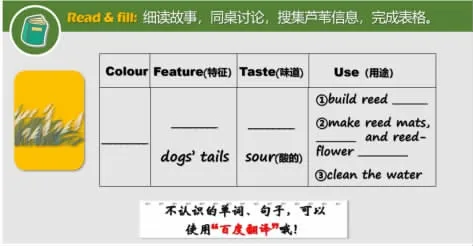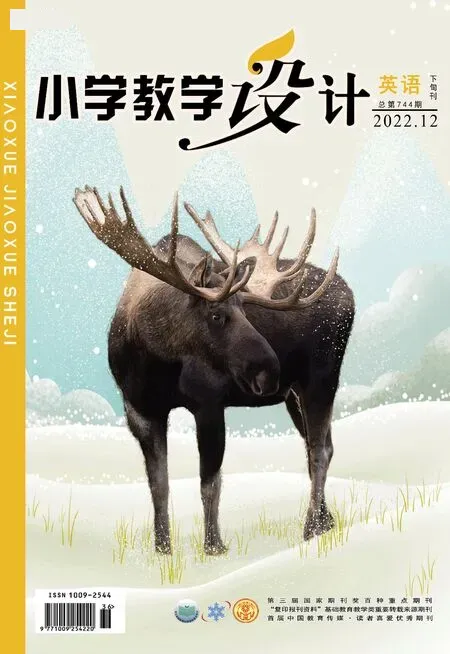译林版《英语》五(上)综合实践活动设计“Wonderful”Wetlands(1 课时)
2022-02-14郑醉榴
文 郑醉榴
一、活动介绍
本实践活动属于“人与自我”“人与自然”主题范畴,涉及“乐学善学,勤于反思,学会学习”“人与自然相互依存,绿色生活的理念和行为”等。
本实践活动围绕“Wonderful Wetlands”设计并实施。该活动设计融入科学、艺术、心理、信息技术等学科,通过补充、调整、整合,弥补并完善学生的知识体系,深化并提升学生的学科思维,开拓并扩展学生的研究视野。
二、活动目标
通过参与“Wonderful Wetlands”实践活动,学生能够:
1.视听、阅读湿地动(植)物的语篇等,在教师引导和启发下获得语篇大意,提取有关湿地动(植)物的信息,如名称、形状、颜色等;
2.通过介绍“Surf the Internet”“Read books”“On-the-spot Experience”三种学习方法,让学生学会探索未知地点的方法;
3.通过观察、阅读、体验等活动,聚焦内涵、情感和生活,指向学生对自然、社会与自我的态度。
三、活动过程
Step 1. Warming-up and leading-in
1.复习旧知,引出主题。
课前出示教师的Name Card,学生就教师姓名、喜欢颜色、兴趣爱好、所在学校等信息进行自由提问。教师提及“My school is special.”引发学生猜测,为后面的教学作铺垫。
T: Hello, I’m a new teacher. Look, here is some information about me. Do you have any questions?
S1: Hello, teacher, what’s your name?
T:My name is... You may call me...
S2:What colour do you like best?
T:I like...
S3:Do you have an animal friend?
T: Yes, it has red eyes,long ears and a short tail. What is it?
S3:Oh, it’s a rabbit.
S4: Where do you come from?
T: I come from Shimao Primary School. Look, it’s very special. It’s next to a wetland.(教师出示学校照片。)
设计意图:“wetland”对于学生来说是一个陌生的词,湿地对于学生来说也是一个陌生的地域。为消除陌生感,教师在热身环节设置了轻松愉悦的问答活动,拉近师生之间的距离,并顺畅引出本课主题“wetland”。在此过程中,学生也复习了颜色、特征等表达方式,唤醒了旧知,突破了后续学习中的难点。
2.师生对话,激发兴趣。
T:What is a wetland? You may ask me some questions.
S1:What’s in the wetland?
S2:What can we see/do in the wetland?
S3:Are there any animals in the wetland?
...
设计意图:在师生的进一步谈话中,逐渐形成“什么是湿地”“湿地里有什么”“湿地里可以做什么”等一系列问题链,这些都是基于学生的已有知识产生的真实问题,让学生对湿地产生浓厚的兴趣,同时也为后续综合实践活动的开展做好了铺垫。
Step 2. Presentation
Task 1:Surf the Internet
T:Wow,you have so many wonderful questions about wet -lands. Today I will introduce you some ways to know a wetland well. Here is the first way“Surf the Internet”.
(教师出示iPad 以及百度网页)
T: I usually use“Baidu”to look up information. Now, please enter the keywords “Wetland”,and tell me what you can see.
(学生使用iPad,在百度网页中输入wetland)
S1: I can see some nice pictures.
S2: I can see the words about wetlands.
S3:I can see some videos about wetlands.
T:Now,let’s enjoy some beautiful pictures first.(学生欣赏湿地美图)What can you see?
Ss:Rivers, animals, plants...
T: And here are some words about wetlands. What is the wetland like?
Ss:Soft, wet, low...
T: I also have a video about wetlands, let’s enjoy.
...
T:I think you must know“wetland”well. Now please judge“What wetlands are the”.

设计意图:在了解湿地的第一种方法“上网搜索”中,教师提供iPad,让学生真实体验上网过程。教师通过展示“百度图片”,让学生欣赏美景,初步感受湿地;通过出示“百度百科”,让学生知晓概念,逐步了解湿地;通过播放“百度视频”,让学生细化认知,全面认识湿地。通过这三个环节,学生已掌握湿地的基本特征并形成初步印象。在此基础上,教师借助“百度百科”,让学生判断“哪些是湿地”,从而进一步深化认知,并得出第一个“学习小贴士”:The Internet can help us know a new place quickly.
Task 2:Read books
T:The students in Shimao wrote many stories about“wetland”,this is one of them.
(教师出示学生Anna 写的故事“A Wonderful Walk”)
(1)Watch and answer:Where do they have a wonderful walk?
Jiyanghu Wetland.(暨阳湖湿地)
(2)Read and find: What are the animals or plants mentioned in the story?
Reeds, crabs, egrets.
(3)Read and fill: Please collect the information about reeds and fill in blanks.
学 生 从 colour、 feature、taste、use 等方面,在文中寻找关键信息填入表格。

设计意图:在了解湿地的第二种方法“故事阅读”中,教师出示了学生Anna 撰写的湿地故事“A Wonderful Walk”。在该语篇中,有语言知识(They can... They like... They have...);有生活知识(如爷爷小时候;芦苇可用来做席子、鞋子等);有观点看法(如芦苇可以净化水质等),较为全面地介绍了湿地文化知识,满足了学生的学习需求。学生通过视听、合作、上网等,获得语篇大意,学会提取有关湿地动(植)物的信息,如名称、形状、颜色等由此得出第二个“学习小贴士”:Books can help us know a new place vividly.
Task 3:On-the-spot Experience
T:In the story, we know Anna went to the wetland. And that is also a good way to know“wetland”well. We call it“Onthe-spot Experience”. And how to experience?
S1: We use our eyes to watch.
S2: We use our ears to listen.
...
T:The students in Shimao have On-the-spot Experiences in the wetland. Let’s enjoy(播放学生活动视频). What can we do in a wetland?
S1:We can climb trees.
S2:We can have picnics.
...
T:Yes, we can also have a study. And we can bring a study sheet with us.
教师介绍如何使用研学单,模拟开展湿地学习活动,环节如下:
(1)确定研究主题:学生选择研究主题(egrets 或crabs)。
(2)尝试观察整理:学生观察iPad 中存入的关于egrets 或crabs 的图片、文字、视频,根据研学单,提取关键信息。
(3)完成学习任务:组长分配任务,组员分工合作,通过看、写、画等方式,完成研学单。
(4)分享学习成果:小组汇报,展示研学成果。

设计意图:在了解湿地的第三种方法“实地体验”中,由于该教师是异地上课,不能把学生带入湿地实景中,因此设置了现场模拟湿地学习活动。学生根据习得的方法,小组分工开展完成研学单的任务,培养团队合作意识。在观察和体验的过程中,学生通过独立自主或伙伴合作,利用研学单完成对信息的搜集、整理与分析,完成动(植)物信息卡。活动中,学生参与了核心问题的研讨,经历了思考和解决问题的过程,在思维互动中学会了合作和分享。最后,教师带领学生得出第三个“学习小贴士”:Onthe-spot Experience can help us know a new place deeply.
Step 3. Consolidation and promotion
T: Now, can you say something about“wetlands”?
Ss:Wetlands are beautiful/colourful/meaningful...
T:Wetlands are wonderful,but they were once in danger.(播放湿地危机的视频)
T: What can we do to protect them?
Ss:To be volunteers, don’t cut down trees, do farewell activities...
T:Yes, our Chinese President Xi Jinping also asks us to protect wetlands.(视频介绍习近平主席在2022 年11 月5 日《湿地公约》第十四届缔约方大会开幕式上的致辞,并通过一系列数据,升华“Wonderful wetland, wonderful China.”)
设计意图:通过播放视频,引出湿地危机,介绍学生保护湿地开展的行动,指向学生对自然、社会与自我的态度。通过出示习近平主席的讲话、中国在保护湿地工作上做出的努力以及湿地面积增长的相关数据,升华学生对湿地和祖国的热爱,自然而然引发“Wonderful wetland, wonderful China.”的真实感悟。
Step 4. Homework
1.Try to know more about wetlands.(介绍湿地科普绘本)
2.Try to use the 3 ways to explore new places.(呈现本地风景名胜、博物馆等地点)
设计意图:家庭作业1 是介绍“Swamp Animals”等科普绘本,丰富学生阅读内容;家庭作业2是要求学生用“上网搜索、故事阅读、实地体验”三种方式去探索本地的风景名胜、博物馆等,既是对学习目标的回应,又把学习与生活密切关联,让学生的学习从书本走向更广阔的现实世界。
